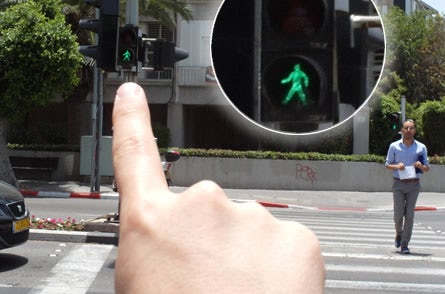I want to share with you the innovative product that Orcam has made possible. It is, as stated on their website, the world’s most advanced wearable artificial vision device and it is truly life changing. The Orcam Myeye makes the blind see again. And that is no exaggeration.
The Myeye is an artificial, portable device that is mounted on the frames of a pair of eyeglasses, which instantly tells you what it sees. The user only needs to point at what they want to read and the device automatically makes a picture, processes the pictures and reads out loud what the picture states. Activated by a simple gesture as pointing your finger (or pressing a button on the device), the Myeye makes newspapers, books, computers, smartphone screens, restaurant menus, labels on supermarket products, street signs accessible – in real time (Orcam, 2017). The device can even recognize friend’s faces. If you look at a friend, click the button and pronounce their name, the Myeye saves the face with that name and every time you meet your friend but you can’t (properly) see him/her, the device reads out their name for you.
That all being said, it is clear to say that the Orcam Myeye is an innovative product that can be seen as a breakthrough for the medical and healthcare industry. However, the Myeye is not the first in its market. There are only a few head-mounted wearable devices which offers visually impaired users discreet and hands-free access to digital information to augment their awareness of and facilitating their interaction with their environment. For instance, take the Google Glass. The difference with the other artificial vision devices, like the Google Glass, is that those existing devices were merely innovative products made for the (full)able-bodied consumers. These are mainly just practical gadgets in order to make life more practical/fun, but the Myeye is really just there to act as a personal aiding assistant for the visually impaired. That difference makes the Myeye operate in the healthcare industry and the other existing vision devices operate in the lifestyle consumer market (Goeppert and Manoli, 2004).
With that being clear, the next question pops my mind. Should the Orcam Myeye be covered by your health insurance? Currently, in the Netherlands, it is not and it makes my wonder why (nu.nl). Sure, the device is pretty expensive, to wit between the €3000,- and €4000,- (orcam.nl). But think about it: it is not only from a ethical perspective to include the vision device in the healthcare system, seeing that it actually changes people’s life, but the Myeye is also actually really beneficial for the government expenses. Because the costs of visually impaired persons for the government to the insurance companies is very high because they need somebody to assist them. But with the vision device it makes people independent. Meaning that they can go back to work, read their texts, buy their own groceries and much more, by having a device in stead op actual people assisting them, which creates great governmental costs reductions.
Concluding that the Orcam Myeye is an innovative product operating in the healthcare industry, digitizing the market by taking over the jobs of assisting the visually impaired. Seeing that the Myeye innovates the current healthcare industry, one could say it is a disruptive technology. I just say that the Orcam Myeye makes the world a better place. What’s your opinion?
By Pieter Spigt
References:
https://www.nu.nl/155162/video/video-met-deze-bril-kunnen-blinden-lezen.html
Danneels, E. (2004), Disruptive Technology Reconsidered: A Critique and Research Agenda. Journal of Product Innovation Management, 21: 246–258. doi:10.1111/j.0737-6782.2004.00076.x
Jacob Goeppert, Yiannos Manoli, “Fully Integrated Startup at 70 mV of Boost Converters for Thermoelectric Energy Harvesting”, Solid-State Circuits IEEE Journal of, vol. 51, pp. 1716-1726, 2016, ISSN 0018-9200

